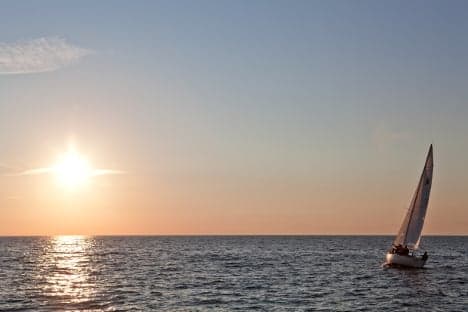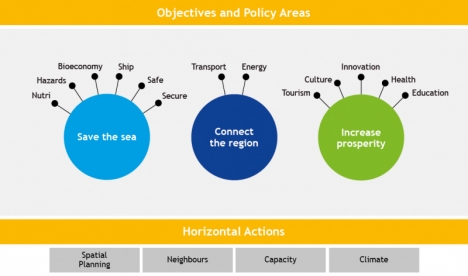Sweden to link Baltic region in new ways
Sweden has new responsibilities in the Baltic Sea region, playing an even more important role in joint efforts to boast prosperity, protect the sea, and keep the region connected.

Earlier in June, the Swedish Institute (SI) was assigned a formal coordinating role in a fresh EU approach to regional cooperation that has since been replicated in other parts of the 27-member bloc.
“There are big synergies with SI’s other activities in the region,” says Jacek Paszkowski, a programme manager with SI’s Baltic Sea Unit. “We’re helping drive development of the strategy forward and making new connections in the region that didn’t exist before.
The new designation puts Sweden at the heart of an evolving strategy for coordinating initiatives across borders in the Baltic region that is “completely opposite” to how Brussels used to promote regional cooperation.
A strategy for the Baltic Region
“Traditionally Brussels decided the goals and the format and invited groups to join,” explains Anders Bergström of the Norden Association, one of SI’s partners on the initiative. “Now we start locally, ask what’s needed, what people want to achieve, and so on. Then build up an initiative together and seek funding to support it. It’s much more proactive.”
Sweden has long been active in strengthening cooperation in the Baltic region, in particular following the collapse of the Soviet Union. SI has even had an office on the Baltic island of Gotland for several years; an office which now serves as an important staging ground for the agency’s beefed up role in implementing the EU’s strategy for the region.
The “strategy” is known formally as The European Union Strategy for the Baltic Sea Region (EUSBSR) and emerged from a 2009 European Council decision creating Europe’s first “macro-regional strategy” – a new approach to regional cooperation that emerged following the EU’s expansion.
“From an EU perspective we’re more homogeneous. We have a lot of common history, common infrastructure and a track record of working together,” explains Paszkowski.
A living document
Following the establishment of the Baltic Sea Region strategy, the Commission has replicated the approach in other regions, developing a set of formal goals and actions applicable to existing geographic constellations such as the Alpine region, or countries along the Danube River.
Paszkowski emphasizes the Baltic Sea Region strategy is a “living document” currently divided into three areas: saving the sea, connecting the region, and increasing prosperity.
The main areas are broken down into more specific policy areas including education, shipping, energy, tourism and several others. In addition, the strategy includes four cross-cutting, functional “horizontal action” areas that work in parallel to support programmes related to the three main themes.
“But the strategy isn’t an end in itself; it’s a tool for realizing long-term goals without having to constantly go to Brussels,” says Paszkowski. “We talk to each other instead.”
One example of the work taking place is School to Work (S2W), which aims to keep young people in school longer to prevent future unemployment and social exclusion.
“People without an education risk staying outside the labour market their whole lives,” says Bergström. “We work with a whole range of organizations that represent teachers, parents, school administrators, city government, and employers in a hands on way that could never be achieved from Brussels.”
As one of many so-called “Flagships” underway within the EU Baltic Sea Region strategy, S2W aims to strengthen transnational cooperation in tackling the challenge of youth unemployment.
Capacity building
But to be successful, the EU’s “macro-region” approach also requires new thinking and retooling among the organizations and public agencies that previously just waited for calls for applications for EU funding.
“Many are reluctant to join EU funded activities or don’t really understand the new approach,” Bergström continues. “We’re there to let them know they can participate and equip them with the necessary knowledge and skills to make use of the strategy.”
For example, in order to help make the School to Work initiative possible, SI provided seed funding so that interested groups could meet and write funding applications to get the programme started.
This sort of capacity building work falls into one of the four “Horizontal Actions” and is an example of activities that SI will now formally coordinate and administer within the larger Baltic Sea Region strategy.

An overview of the Baltic Sea Region strategy
“We help build bridges that connect people and also lay the foundation for future cooperation,” Paszkowski says.
“When one country is trying to solve a problem, it’s often useful to import methods or parts of the solution from other countries. The result and ultimate solution is a puzzle with many pieces that no one country could have put together on its own.”
Bergström points to the sort of knowledge sharing across borders and sectors currently on display this week during Almedalen as a metaphor for the work of SI and other groups working to deepen Baltic cooperation.
“Almedalen is an excellent venue to build different partnerships. All levels of government are represented, as well as NGOs, interest groups, business, and academia,” he says. “It’s really useful to have all these people come together in a single meeting place. No single theme dominates and the networking opportunities are amazing.”
'A truly Baltic Almedalen'
This year at Almedalen, SI has held Baltic region-themed seminars covering topics ranging from security and defence cooperation; how best to cooperate with Russia; and strategies for fostering and harnessing innovation across the Baltics.
And while Almedalen is a wonderful forum and has become more international in recent years, the theme of Baltic cooperation doesn’t get as much attention as Paszkowski would like amid the thousands of seminars on offer.
An alternative, he suggests, would be to launch another week – a Baltic Sea Week modelled on Almedalen, but held in English and designed expressly to discuss pressing issues from a Baltic perspective.
“Gotland, out here in the middle of the Baltic Sea, is a natural location to discuss these issues,” he says. “It’s time for a truly Baltic Almedalen.”
This article was produced by The Local in partnership with the Swedish Institute.
This content was paid for by an advertiser and produced by The Local's Creative Studio.

Join the conversation in our comments section below. Share your own views and experience and if you have a question or suggestion for our journalists then email us at [email protected].
Please keep comments civil, constructive and on topic – and make sure to read our terms of use before getting involved.
Please log in here to leave a comment.